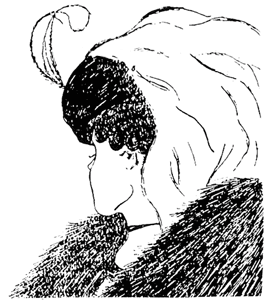The next story I tackled was Poe’s 1842 story “The Oval Portrait.” Here is the summary from Wikipedia:
The tale begins with an injured narrator seeking refuge in an abandoned mansion in the Apennines, with no explanation for his wound. He spends his time admiring the works of art decorating the strangely-shaped room and perusing a volume which "purported to criticize and describe" the paintings. He eventually discovers a painting which shocks him with its extreme realism, which he refers to as "absolute life-likeliness of expression". He spends a moment ("for an hour, perhaps", the reader is told) in silent awe of it until he cannot bear to look any more, then consults the book for an explanation.
The remainder of the story is a selection from this book discussing how the painting was created — a story within a story. The book explains that the picture was painted by an eccentric artist depicting his young wife, but that he grew obsessed with his painting to the point that he paid no attention the woman he was painting. When he finishes the painting he is appalled at his own work, and exclaims, "This is indeed Life itself!" Then he turns to see his bride, and discovers that she has died and her spirit was transferred into the lifelike painting.
The story was originally published as “Life in Death” and is the shortest of Poe’s stories. It was also the inspiration for Oscar Wilde’s novel The Picture of Dorian Gray. The actual story of the portrait only takes a single paragraph to tell, and everything else leading up it that story seems like filler. It was precisely because it was Poe's shortest work that I thought it would lend itself well to matchbox treatment. Instead I found it to be the most frustrating stage to craft.
Beginning in the usual manner, I put a white base coat on the box of matches (2 1/16" x 1 3/8" x 1/2").
I almost immediately discovered my error in choosing to interpret “The Oval Portrait.” The painting is supposed to be so lifelike that it holds the soul of the young woman it depicts. Not being an artist this became a daunting task for me. After a few attempts to find an appropriate painting for inspiration, I gave up and tried a different tactic.
The portrait obviously came from the very famous optical illusion of the young maiden and the old hag.

I had hoped that it would allow the oval portrait to convey the idea of the painting draining the life of the young bride. Mostly though it just looks like the very famous optical illusion of the young maiden and the old hag.
Next I created a 2” x 1” artist’s pallet and enlisted one of the penny matches as a paintbrush. The idea being that as the performer told the story of the portrait; they could act out the painting of the actual portrait.
At the beginning of the story the wounded narrator and his servant break into an abandoned chateau. It is in the bedroom where the narrator is recovering that he sees the portrait.
The chateau at the beginning of the story was referenced from an image of the Chateau Les Roches, a bed and breakfast in Burgundy, France. I attempted to make my painting of the Chateau larger in scale and it probably only has a passing resemblance to the real country house.

Below are the characters of painter and his wife. The characters are acrylic on poster board. Instead of being mounted on matches, this time the figures are mounted into the studio. It ultimately creates a diorama more than an actual theater.
As you can see model sitting in her wedding gown in no way resembles the actual finished oval portrait.
The artist’s studio was referenced from an image of Horace Vernet’s 1820 oil painting “The Artist’s Studio.” My own artist’s look was taken from the painter sitting in the bottom left corner of Vernet’s work.

Feeling that the optical illusion portrait failed to capture the fate of the Artist's wife, I added a painting to the backside of the interior diorama. I'm afraid though that the wife doesn't look dead so much as a little tired.
For me this turned out to be the weakest of my Poe-Dunk theaters, and I won't be surprised to see it replaced in the rotation of short plays.
Next week: "Desultory Notes on Cats."
